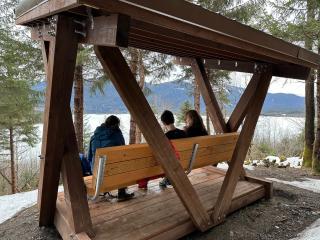Alaska Eagle Scout project resurrects Mendenhall Glacier Recreation Area bench

ALASKA—Paul King, a Juneau Douglas High School senior, needed an Eagle Scout project.
“One day, while hiking around, I noticed a bench falling apart,” said King. The bench sat within the Mendenhall Glacier Recreation Area, over a mile up West Glacier Trail, at the top of a hill of switchbacks.
The bench was built in the mid-1990s when the selected location featured a spectacular, unobstructed view of the iconic Mendenhall Glacier. Back then, the glacier was much closer, and less time had passed since the glacier flowed over the site—scraping vegetation from rocks and supporting an open vista.
As trees took root and grew around the bench, it eventually fell into obscurity. Fewer and fewer people knew it was there. For those lucky enough to find it, views of the diminishing glacier were masked by surrounding trees. The bench began to fall apart. The roof, once an asset in the temperate rainforest, leaked.
King recognized the bench’s potential and, at first, thought his project would be to repair it. As he envisioned his next steps, he realized it would make more sense to replace it with a bench that might endure for generations.
Rebuilding the bench allowed King to reorient it to the changed scenery. In recent decades, the panorama of the glacier has been replaced by views of steep mountainsides, carved by millennia of ice. Rotating the bench 45 degrees would enable users to enjoy an expanded line of sight, highlighting other features, such as the spectacular Mendenhall Lake, which rests on the area once occupied by the glacier.
King, who plans to study engineering in college, got to work drafting a 3D Computer-Aided Design model based on another bench he had seen in the Juneau area. He collaborated with a local engineer to ensure that it would withstand the local snow load and wind and provide improved shelter from the rain. Local welders agreed to make the required specialized brackets.
After receiving approval to build, King began cutting and drilling holes in the lumber in his garage, preparing rock, and pouring concrete at the installation site.
With all the components ready, it was time for installation. A Juneau helicopter operator offered to drop materials and tools at the site, free of charge. Forest Service employees also pitched in, providing a rock drill and assisting the helicopter drop with a sling, carry bag and their expertise. Additionally, staff cleared trees to bring the bench and landscape into view of hikers traversing West Glacier Trail.
King assembled a crew of a dozen volunteers, including Scouts and church members. One snowy December day, the group hiked to the spot where they would eventually bring the project to fruition. “About six of us assembled the bench and the other half cleared out the remaining brush and trimmed smaller things out of the way,” explained King.
With the view restored, recreators can now look across the lake to see the historic Mendenhall Glacier Visitor Center, the first Forest Service visitor center in the country, constructed in 1962. Visitors can also watch the sun set over the horizon or glimpse mountain goats descending to the rock peninsula to feed on lichen and vegetation when the mountaintops are buried in snow.
King hopes the bench will be used for generations by people looking not only for a stunning view, but also for a nice spot to rest while on a hike. By summer, one of those hikers might be Juneau’s most recent Eagle Scout, ready to test out his creation.
The original bench was constructed around 30 years ago by the Juneau Home Builders Association. It served as a memorial to Preston “Buck” Burnett, who was active in rebuilding a nearby Forest Service cabin—Skaters Cabin—after it was vandalized by fire. Soon after the original bench was built, a local Eagle Scout constructed the bench’s original roof shelter. Paul King’s project is contributing to a legacy of community members and Eagle Scouts building a refuge for recreators on West Glacier Trail.





